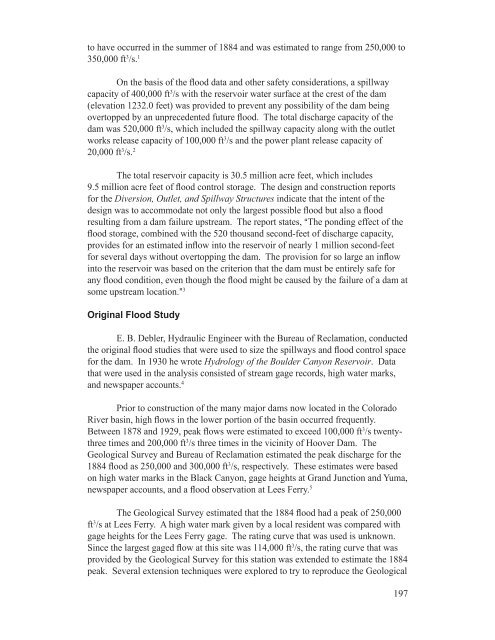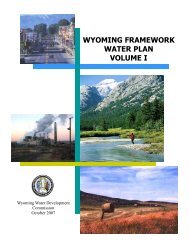Evolution of the Hoover Dam Inflow Design Flood: A Study in ...
Evolution of the Hoover Dam Inflow Design Flood: A Study in ...
Evolution of the Hoover Dam Inflow Design Flood: A Study in ...
Create successful ePaper yourself
Turn your PDF publications into a flip-book with our unique Google optimized e-Paper software.
to have occurred <strong>in</strong> <strong>the</strong> summer <strong>of</strong> 1884 and was estimated to range from 250,000 to<br />
350,000 ft 3 /s. 1<br />
On <strong>the</strong> basis <strong>of</strong> <strong>the</strong> flood data and o<strong>the</strong>r safety considerations, a spillway<br />
capacity <strong>of</strong> 400,000 ft 3 /s with <strong>the</strong> reservoir water surface at <strong>the</strong> crest <strong>of</strong> <strong>the</strong> dam<br />
(elevation 1232.0 feet) was provided to prevent any possibility <strong>of</strong> <strong>the</strong> dam be<strong>in</strong>g<br />
overtopped by an unprecedented future flood. The total discharge capacity <strong>of</strong> <strong>the</strong><br />
dam was 520,000 ft 3 /s, which <strong>in</strong>cluded <strong>the</strong> spillway capacity along with <strong>the</strong> outlet<br />
works release capacity <strong>of</strong> 100,000 ft 3 /s and <strong>the</strong> power plant release capacity <strong>of</strong><br />
20,000 ft 3 /s. 2<br />
The total reservoir capacity is 30.5 million acre feet, which <strong>in</strong>cludes<br />
9.5 million acre feet <strong>of</strong> flood control storage. The design and construction reports<br />
for <strong>the</strong> Diversion, Outlet, and Spillway Structures <strong>in</strong>dicate that <strong>the</strong> <strong>in</strong>tent <strong>of</strong> <strong>the</strong><br />
design was to accommodate not only <strong>the</strong> largest possible flood but also a flood<br />
result<strong>in</strong>g from a dam failure upstream. The report states, AThe pond<strong>in</strong>g effect <strong>of</strong> <strong>the</strong><br />
flood storage, comb<strong>in</strong>ed with <strong>the</strong> 520 thousand second-feet <strong>of</strong> discharge capacity,<br />
provides for an estimated <strong>in</strong>flow <strong>in</strong>to <strong>the</strong> reservoir <strong>of</strong> nearly 1 million second-feet<br />
for several days without overtopp<strong>in</strong>g <strong>the</strong> dam. The provision for so large an <strong>in</strong>flow<br />
<strong>in</strong>to <strong>the</strong> reservoir was based on <strong>the</strong> criterion that <strong>the</strong> dam must be entirely safe for<br />
any flood condition, even though <strong>the</strong> flood might be caused by <strong>the</strong> failure <strong>of</strong> a dam at<br />
some upstream location.@ 3<br />
Orig<strong>in</strong>al <strong>Flood</strong> <strong>Study</strong><br />
E. B. Debler, Hydraulic Eng<strong>in</strong>eer with <strong>the</strong> Bureau <strong>of</strong> Reclamation, conducted<br />
<strong>the</strong> orig<strong>in</strong>al flood studies that were used to size <strong>the</strong> spillways and flood control space<br />
for <strong>the</strong> dam. In 1930 he wrote Hydrology <strong>of</strong> <strong>the</strong> Boulder Canyon Reservoir. Data<br />
that were used <strong>in</strong> <strong>the</strong> analysis consisted <strong>of</strong> stream gage records, high water marks,<br />
and newspaper accounts. 4<br />
Prior to construction <strong>of</strong> <strong>the</strong> many major dams now located <strong>in</strong> <strong>the</strong> Colorado<br />
River bas<strong>in</strong>, high flows <strong>in</strong> <strong>the</strong> lower portion <strong>of</strong> <strong>the</strong> bas<strong>in</strong> occurred frequently.<br />
Between 1878 and 1929, peak flows were estimated to exceed 100,000 ft 3 /s twentythree<br />
times and 200,000 ft 3 /s three times <strong>in</strong> <strong>the</strong> vic<strong>in</strong>ity <strong>of</strong> <strong>Hoover</strong> <strong>Dam</strong>. The<br />
Geological Survey and Bureau <strong>of</strong> Reclamation estimated <strong>the</strong> peak discharge for <strong>the</strong><br />
1884 flood as 250,000 and 300,000 ft 3 /s, respectively. These estimates were based<br />
on high water marks <strong>in</strong> <strong>the</strong> Black Canyon, gage heights at Grand Junction and Yuma,<br />
newspaper accounts, and a flood observation at Lees Ferry. 5<br />
The Geological Survey estimated that <strong>the</strong> 1884 flood had a peak <strong>of</strong> 250,000<br />
ft 3 /s at Lees Ferry. A high water mark given by a local resident was compared with<br />
gage heights for <strong>the</strong> Lees Ferry gage. The rat<strong>in</strong>g curve that was used is unknown.<br />
S<strong>in</strong>ce <strong>the</strong> largest gaged flow at this site was 114,000 ft 3 /s, <strong>the</strong> rat<strong>in</strong>g curve that was<br />
provided by <strong>the</strong> Geological Survey for this station was extended to estimate <strong>the</strong> 1884<br />
peak. Several extension techniques were explored to try to reproduce <strong>the</strong> Geological<br />
197
















